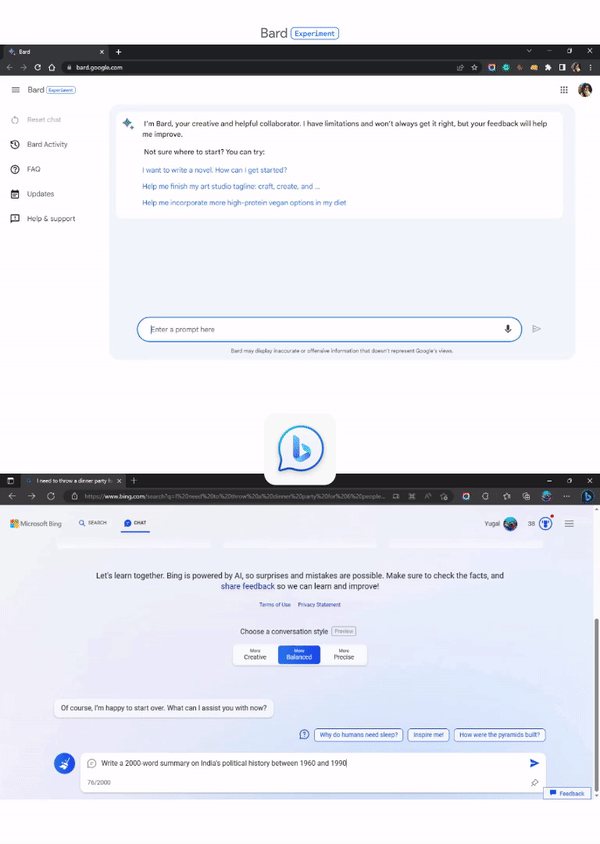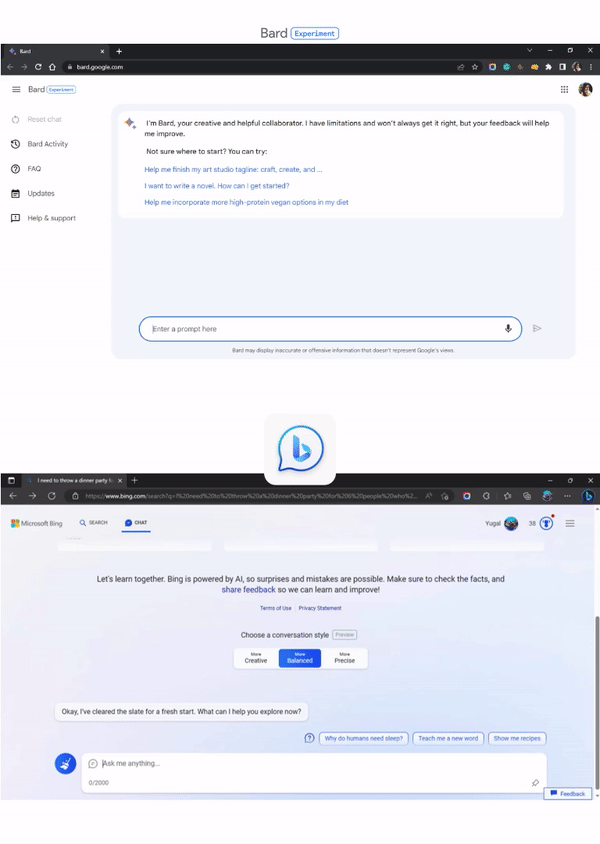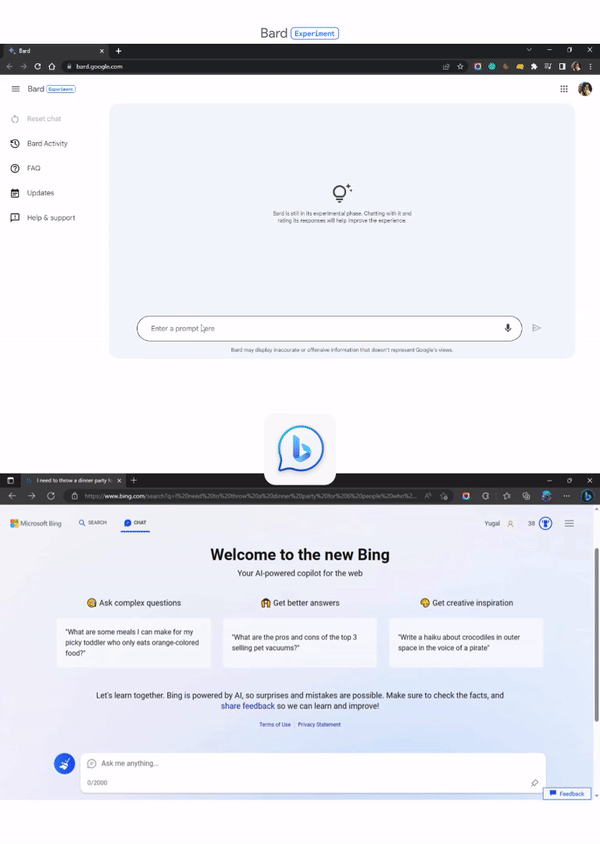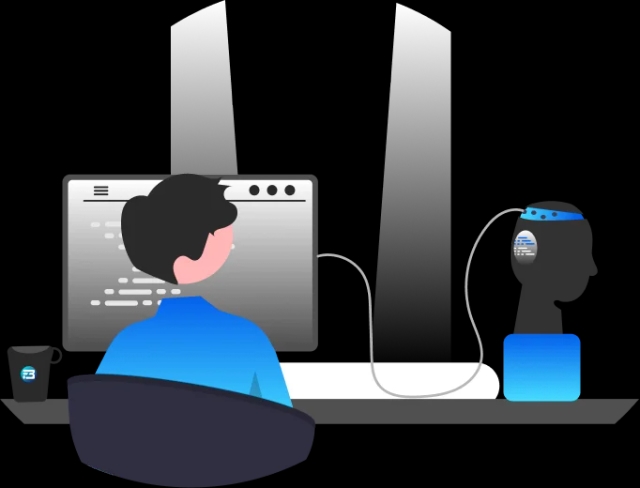ChatGPT
Bard
The AI Chat Bot Battle: Google’s Bard vs Microsoft’s Bing Search
Step into the world of AI as we compare Google's Bard and Microsoft's Bing Search, delving into their features, strengths, and areas for improvement.
ChatGPT
Bard
Step into the world of AI as we compare Google's Bard and Microsoft's Bing Search, delving into their features, strengths, and areas for improvement.

It’s impossible to ignore the impact of ChatGPT and Microsoft Bing in the AI landscape. Recently, Bing reached a milestone of 100 million active users, a feat some attribute to ChatGPT, even suggesting it could be the reason for Google’s potential downfall.
Google’s response is the experimental AI chatbot Bard, which we will test in this blog, comparing it to Microsoft’s ChatGPT in various challenges.
When using Google’s Bard, two things immediately become apparent. First, Bard is remarkably fast, surpassing ChatGPT in response time.
.gif) Second, it offers a “view other drafts” toggle, giving users multiple drafts for the same answer in varying lengths and tones. This feature enhances user experience by providing alternative responses.
Second, it offers a “view other drafts” toggle, giving users multiple drafts for the same answer in varying lengths and tones. This feature enhances user experience by providing alternative responses.
But more than this the better question is who is better?
Well, let’s test them out side by side!
We challenged both chatbots to write a 2000-word summary of India’s political history between 1960 and 1990.
 Google’s Bard delivered a quick, accurate response, starting with Jawaharlal Nehru’s death, the emergency, and economic liberalization.
Google’s Bard delivered a quick, accurate response, starting with Jawaharlal Nehru’s death, the emergency, and economic liberalization.
Bing now on the other hand has three modes: ✨Creative, ☯Balance, and 🎯Precise
We leave it to “☯Balance” because that’s the default mode and what most people would use!
Bing’s ChatGPT, however, chose to provide Wikipedia links rather than a summary.
The score is
Bard — 😎 1
Bing — 🥴 0
We upped the ante by asking the chatbots to write a creative YouTube short script in Snoop Dogg’s style, ending with a call to action to like, share, and subscribe.
 Bing’s ChatGPT outperformed Google’s Bard, delivering a well-crafted rap script that effectively conveyed the message.
Bing’s ChatGPT outperformed Google’s Bard, delivering a well-crafted rap script that effectively conveyed the message.
Bard’s response was decent but fell short in comparison.
The score now stands at
Bard — 😎 1
Bing — 😎 1
In the most challenging test, we asked the chatbots to write an HTML code that opens 20 YouTube tabs with a single button click.
 Google’s Bard said it limited to answers only in the text as it’s in a testing version to provide a working code, whereas Bing’s ChatGPT at first it started writing code but finishing more than half a code it said “My apologies, I’m not meant to write code. But then again I tried refreshing the site and delivered a working functional code.
Google’s Bard said it limited to answers only in the text as it’s in a testing version to provide a working code, whereas Bing’s ChatGPT at first it started writing code but finishing more than half a code it said “My apologies, I’m not meant to write code. But then again I tried refreshing the site and delivered a working functional code.
The final Score:
Bard — 🥴 1
Bing — 😎 2
Microsoft’s Integration and Rapid Pace
Microsoft has been rapidly integrating AI technologies, such as DALL-E 2, into Bing, which gives it a competitive advantage over Google. For example, Bing’s Image Creator allows users to request specific images that the AI generates on demand. Although Bing has reached 100 million daily active users, it still has a long way to go to catch up to Google’s 1 billion.
.gif) [ Image Source]
[ Image Source]
Google’s Bard runs on a language called LaMDA (Language Model For Dialogue Applications), which has significantly improved Google’s search capabilities since 2021. LaMDA allows the search engine to better understand human speech and conversational patterns. This development indicates that Google is prepared for the AI competition.
It’s essential to consider the bigger picture when comparing these tech giants. Google’s primary revenue-generating products are ad-serving platforms, while Microsoft’s top products include Office 365 and Azure cloud services. AI integration in these products will likely determine the future success of each company.
As it stands, Bing and ChatGPT appear to be stronger than Google’s Bard. However, with AI technology rapidly evolving and both tech giants pushing their limits, it’s impossible to predict the ultimate winner. The AI war is on, and only time will reveal the true champion.
Try Bing Search
Try Bard
Acquiring high-quality AI datasets has never been easier!!!
Get in touch with our AI data expert now!
